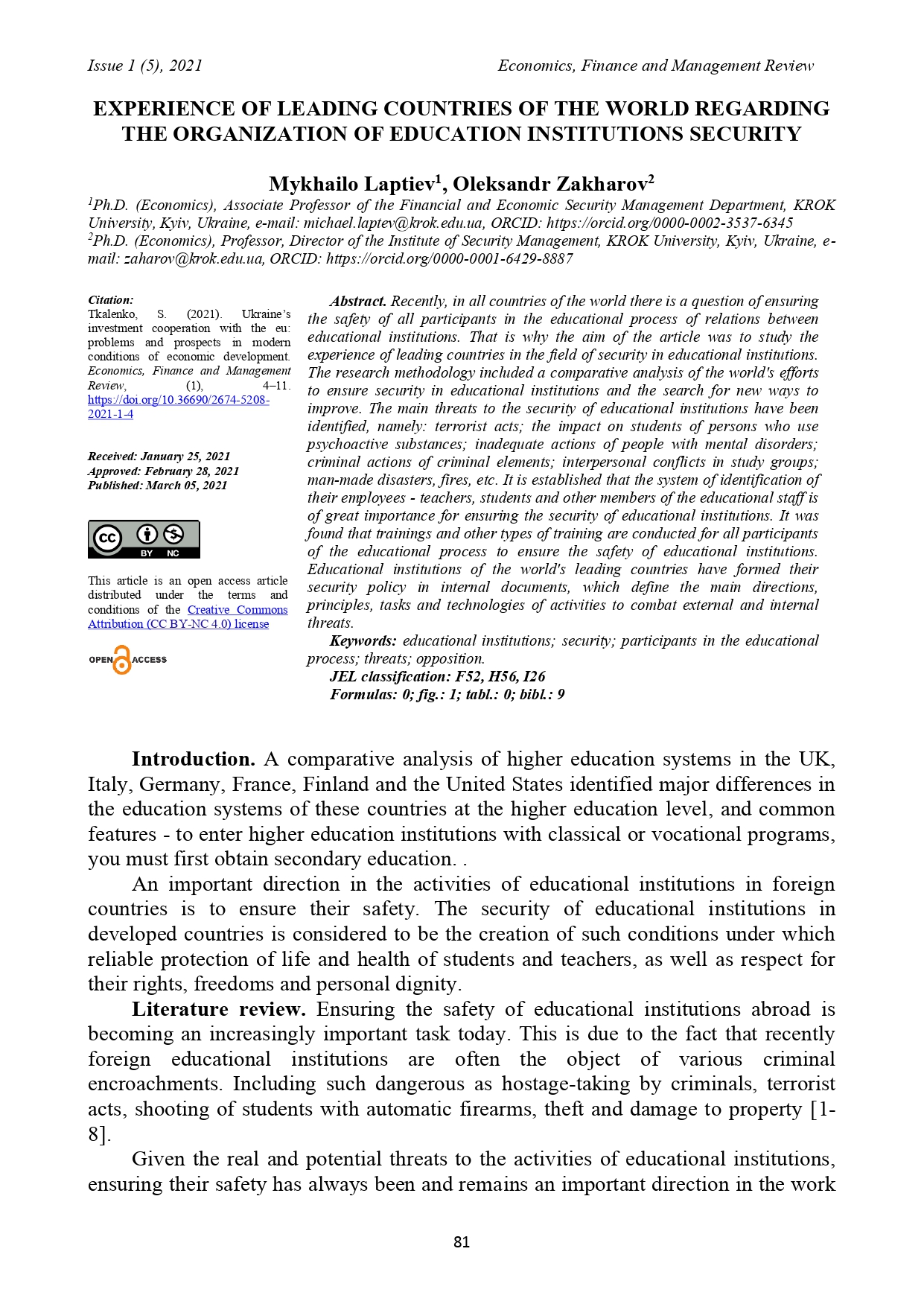EXPERIENCE OF LEADING COUNTRIES OF THE WORLD REGARDING THE ORGANIZATION OF EDUCATION INSTITUTIONS SECURITY
DOI:
https://doi.org/10.36690/2674-5208-2021-1-81Keywords:
educational institutions, security, participants in the educational process, threats, oppositionAbstract
Recently, in all countries of the world there is a question of ensuring the safety of all participants in the educational process of relations between educational institutions. That is why the aim of the article was to study the experience of leading countries in the field of security in educational institutions. The research methodology included a comparative analysis of the world's efforts to ensure security in educational institutions and the search for new ways to improve. The main threats to the security of educational institutions have been identified, namely: terrorist acts; the impact on students of persons who use psychoactive substances; inadequate actions of people with mental disorders; criminal actions of criminal elements; interpersonal conflicts in study groups; man-made disasters, fires, etc. It is established that the system of identification of their employees - teachers, students and other members of the educational staff is of great importance for ensuring the security of educational institutions. It was found that trainings and other types of training are conducted for all participants of the educational process to ensure the safety of educational institutions. Educational institutions of the world's leading countries have formed their security policy in internal documents, which define the main directions, principles, tasks and technologies of activities to combat external and internal threats.
Downloads
References
Klein, J. I., & Rice, C. (2014). US education reform and national security (No. 68). Council on Foreign Relations.
Tania Saeed & David Johnson (2016) Intelligence, Global Terrorism and Higher Education: Neutralising Threats or Alienating Allies?, British Journal of Educational Studies, 64:1, 37-51, DOI: 10.1080/00071005.2015.1123216
Uc, Davis. June 18 2003. June 18, Conflicts and Challenges: Reconciling security practices with university privacy policy. IT Security Symposium.
Sari, P. K., & Nurshabrina, N. (2016, April). Factor analysis on information security management in higher education institutions. In 2016 4th International Conference on Cyber and IT Service Management (pp. 1-5). IEEE.
Shah, M. J., Akhtar, G., Zafar, H., & Riaz, A. (2012). Job satisfaction and motivation of teachers of public educational institutions. International Journal of Business and Social Science, 3(8).
Purpura, P. (2014). Threats and Hazards at Educational Institutions. In The Handbook for School Safety and Security (pp. 11-18). Butterworth-Heinemann.
Lakhno, V. A., Kasatkin, D. Y., Blozva, A. I., & Gusev, B. S. (2019, January). Method and model of analysis of possible threats in user authentication in electronic information educational environment of the university. In International Conference on Computer Science, Engineering and Education Applications (pp. 600-609). Springer, Cham.
Perdikou, S., Horak, J., Halounová, L., Palliyaguru, R., & Lees, A. (2016). The capacity of European Higher Educational Institutions to address threats imposed by natural hazards. Natural hazards, 81(3), 1447-1466.
Laptiev, М. (2019), “Providing security for educational institutions in foreign countries”, Ekonomika ta derzhava, vol. 6, pp. 69–73. DOI: 10.32702/2306-6806.2019.6.69

Downloads
Published
How to Cite
Issue
Section
License

This work is licensed under a Creative Commons Attribution-NonCommercial 4.0 International License.








